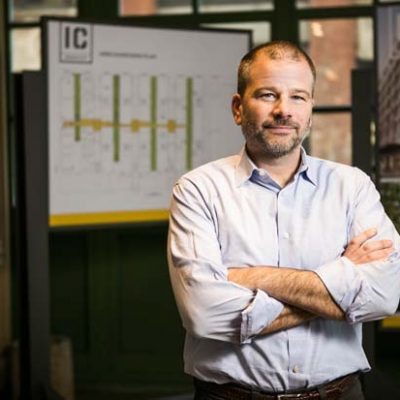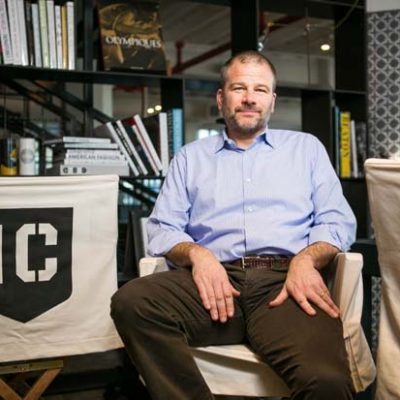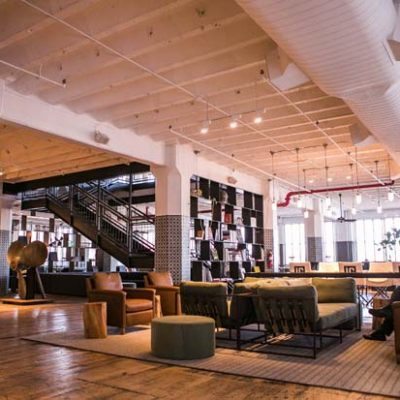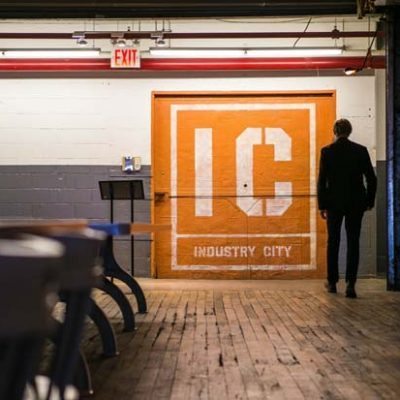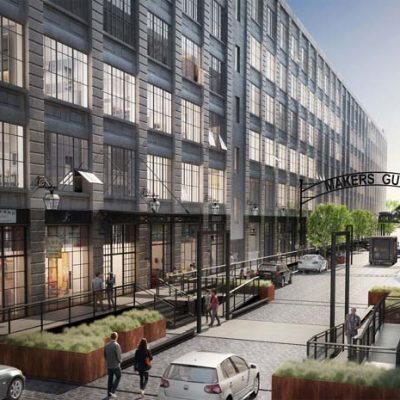AFTER SITTING NEARLY DORMANT FOR A HALF-CENTURY, A ONCE ECONOMICALLY VITAL 30-ACRE SITE ON THE SUNSET PARK WATERFRONT IS BOOMING AGAIN. HOW ANDREW KIMBALL HELPED WRITE INDUSTRY CITY’S TURNAROUND TALE
BY AMANDA McCOY • PHOTOS BY ALEX BARRETO
For long stretches of his two-decade residency in the city’s largest borough, Andrew Kimball, a longstanding champion of innovation economy, would drive past and admire a colossal but nearly vacant complex of industrial warehouses from 31st to 39th Streets, just west of the BQE.
“I’d been driving past these spectacular blocks for so many years, looking in the windows there and seeing either nothing or boxes. I wondered how could it be that these beautiful buildings had nothing going on in them,” said the Hamilton College graduate, now sitting inside one of those refurbished structures on 36th Street.
Vacancy hadn’t always plagued the 125-year-old old industrial complex. In the late 1800s, even before Brooklyn officially joined the city ménage, a complex of staggering scale broke ground alongside the thriving industrial waterfront of Sunset Park. During the following half century of its existence, the at-its-peak 200-acre Bush Terminal boomed in the city’s manufacturing and warehousing realms, thanks to a strategic location aside one of the world’s busiest international seaports and its then-revolutionary integrated business ecosystem that generated 25,000 jobs.
But in the days after World War II, the manufacturing landscape changed radically, and the once-flourishing Industry City (IC) sat as a nearly idle giant during the latter part of the 20th century.
Two years ago, however, after a multifaceted career focused primarily on urban transformation, Kimball was brought to Industry City through a dynamic partnership among the investment and management company Jamestown, the investment firm Angelo Gordon & Co., and Belvedere Capital to catapult the complex into the next phase of its existence.
This isn’t the NYC native’s first dance with the immense revitalization initiative of a fallen industrial powerhouse. He spent eight years spearheading the transformation of the 300-acre Brooklyn Navy Yard, leveraging $1 billion in public and private funding and generating thousands of new jobs. What was once nothing more than an abandoned collection of empty buildings is now a vibrant, artisanal populace of creators, including Steiner Studios.
Now Kimball was tasked with doing it again, only this time entirely within the private sector (which he knew would be a major game-changer), and he was enthusiastic about the challenge. “My time at Brooklyn Navy Yard was defining on many different fronts, and piqued my interested in converting to the full private sector,” he said. “This was an opportunity to show that innovation of economy could work in a completely different environment.”
In 2013, when the new CEO took his first steps on the 6-million-square-foot property, there were only 1,900 jobs onsite and millions of dollars in deferred maintenance to contend with; thousands upon thousands of windows, elevators, roofs, and bulkheads all needing serious attention. But unlike his tenure at the Navy Yard, Kimball and team relied fully on capital investment rather than public grants to achieve the transformation. Industry City needed investors both willing to take a risk and possessed of enough patience to see a project of this prodigious scope to fruition.
“The first two years were a period of credibility and viability. We needed to create a sense of place, of community. The answer has been a resounding yes.”
Over those years, the number of IC-associated jobs has risen to 4,000 (with a goal of 20,000 in the next decade), and the complex’s eclectic mix of tenants would warm any entrepreneurial heart: artisanal makers, designers, garment manufacturers, tech startups, local artists, and many other businesses are gathering to be a part of the synergistic environment.
“People want to be in an authentic environment,” Kimball said. “They want to be around other makers and innovators, and they want to be in beautiful buildings that have both great history and great bones.”
Local residents are now flocking to once-deserted warehouses to sample the latest Grenache from city wineries during the Brooklyn Crush Wine & Artisanal Food Festival, or browse items from hundreds of local craftspeople and other makers at the highly celebrated Brooklyn Flea +
Smorgasbord.
There is also a considerable wave of large companies relocating departments to the Sunset Park waterfront, because as Kimball pointed out, “These businesses understand that in commerce in this day and age, you must be nimble in the digital media space.” Maker Bot opened a space for manufacturing its 3D printers, while Time Inc. secured a 55,000-square-foot space for its tech, content solutions, and editorial innovation departments.
An enterprise to bring in academic collaborations is also in the hopper, which would create more unique business-to business collaboration opportunities not usually available in this kind of commercial campus. And because Kimball and team are striving to re-create the fully integrated ecosystem of IC’s former glory, plans are in place to erect two full-service hotels to accommodate business travelers.
“There won’t be any other place in the city bringing in such diverse departments, from retail to hotels to academic collaborations. This is a truly unique blend of uses for a single campus.”
Industry City
220 36th Street #2-A / 718.965.6450
industrycity.com




